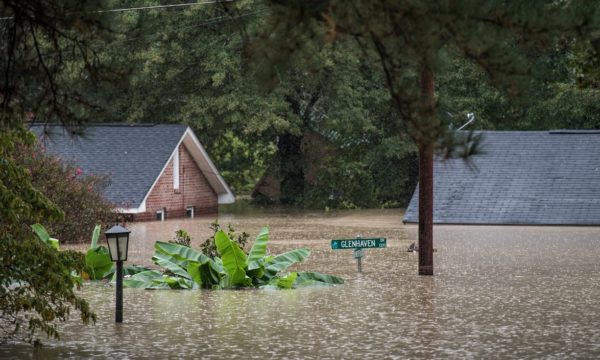Earlier this month, parts of South Carolina were ravaged by floods.
“We haven’t seen this level of rain in the Lowcountry in 1,000 years,” said Governor Nikki Haley.
The rains have slowed, the flooding has stopped, and rebuilding has begun. Schools are back in session, the water advisory has been lifted and people are now making the difficult, and often longer, commutes back to work.
For those who have lost everything or close to it, there are immediate needs like food, shelter, clothing. For parents with infants and small children, they need diapers and baby necessities. Those who live on farms need help caring for their livestock. For others, who may not have lost their homes completely, there is the challenge of finding ways to pay for flood damage when insurance will not pay.
FEMA has already begun assessing damages and many are hoping that they will be eligible for assistance to get back to some semblance of normal. Malcolm Bevel, MSPH, a Ph. D. student in Epidemiology and Biostatistics at the University of South Carolina, has been working with his fraternity, Omega Psi Phi, to rebuild communities and provide for the immediate needs of flood victims.
“I believe that the people who lost everything may still have a sense of hope after the storms,” he says. “Despite the unfortunate loss of some lives and physical possessions, the unity that people showed in the midst of chaos was unquestionably powerful. It can allow people who lost everything to be optimistic about recovering physically, mentally, and spiritually from this natural disaster. However, it will take more time than what we think for people to fully recover.”
Bevel goes on to say that people will need more than just the donations as time passes.
“People will need more than physical items to recover from the floods. Social support is a necessity in these times of despair, so sending prayers and good vibes to the victims of the floods is just one simple way to provide for those in need,” he says. “Months from now, people will need social support from the surrounding communities, faith groups, and others who can just spend just a few minutes out of their busy schedule to make sure that those with less are recovering as best as humanly possible.”
As with many tragedies, when mainstream media bows out from covering the story, the real pain sets in for victims who often feel forgotten. This will lead to feelings of stress, depression, anxiety and even post traumatic stress disorder, or PTSD. For people who have lost everything and were living on fixed incomes with little access to health care, being treated for these chronic conditions will also provide a challenge.
“The unfortunate truth is that poor people and people of color will be more severely impacted and for much longer due to the fact that they did not have the necessary resources in place to cushion the severe blows of the flooding prior to the storm even reaching our great city,” says Bevel. “Local and statewide policies need to be looked at closely so then history won’t repeat itself, especially not for those in underserved communities.”
South Carolina residents in these communities may be able to seek professional assistance and mental health services from local colleges and universities, particularly HBCUs.
“I believe HBCUs are uniquely suited to provide support to students who have experienced traumatic events including natural disasters,” says Dr. Larry J. Walker of Morgan State University. “The strong sense of communalism can help students who have experienced a singular or multiple natural disasters. It is important that post-secondary institutions, particularly HBCUs, provide new and returning students with comprehensive mental health services. In addition, it is critical that HBCUs provide workshops, webinars, etc. to dispel myths regarding mental health. Based on my research institutions that support students exposed to traumas, including natural disasters are more likely to have higher retention rates.”
Dr. Walker points out specific resources for South Carolina residents.
“Claflin and SCSU have counseling centers that help students cope with certain traumatic events,” he says. “Mental health practitioners play an important role counseling students juggling family, school and peer relationships. It is also important for administrators, faculty and staff to understand that natural disasters happen frequently throughout the United States. Thus, taking a proactive approach could help students excel in the classroom.”
Adults who bear the weight of rebuilding and the financial struggles will not be the only ones needing support in care as time goes on and people recover emotionally from the floods in South Carolina. Careful attention must also be paid to the children who’ve suffered as well.
We tend to think of children of having strong resiliency, but Tyrone Blackburn, Educational Specialist and Doctoral candidate in Cognition and Instruction, says that in adults who must bear the weight of caretaker, the initial stress response can be immediate, but children may have a more delayed response.
“The initial psychological responses are those that will unusually manifest themselves in the first 4-8 months after,” he says. “Where long-term manifestations [are] around a year and can be lifelong. Thus, long-term treatment is vital for those that are in need. Research suggests that long term difficulties following a natural disaster are most likely to be seen among children who had threats to their physical safety, thought they might die during the disaster, report that they were very upset during the disaster, lost their belongings or house as a result, had to relocate in the aftermath, and attended schools following the disaster that had multiple schedule changes, double sessions or a lot of disruptions.”
Parents can expect to see symptoms that are similar to adult disaster victims, says Blackburn.
“Yes, PTSD will be an issue parents will need to be aware and concerned about,” he says. “Children who tend to be anxious are those most likely to develop post-trauma symptomatology following a natural disaster. Research suggests that children who’ve had a pre-existing anxiety disorder prior to a natural disaster are at greater risk of developing PTSD symptoms.”
He adds further that minority of children may be at risk of PTSD as well.
“Symptoms can exhibited over an extended period of time,” he says. “Symptoms may include re-experiencing the disaster during play and/or dreams; anticipating or feeling that the disaster is happening again, avoiding reminders of the disaster, general numbness to emotional topics, and increased arousal symptoms such as inability to concentrate and startle reactions. Although rare, some adolescents may also be at increased risk of suicide if they suffer from serious mental health problems like PTSD or depression.”
Even if children have missed quite a bit of school due to clean-up activities, Blackburn says parents shouldn’t worry so much about retention.
“Student retention usually isn’t a problem as long as they receive the proper services to help them cope,” he says. “Relocation is usually the biggest factor in student retention. Most families are displaced after a natural disaster. Thus, the new school district may not have the resources to assist students.”
However, if students are able to return to their home school, academically they should be fine.
Hopefully, as time passes, the nation will continue to remember those affected and offer support and kind words to those in South Carolina. Unfortunately, this was but one of many major tragedies this year from which residents are still healing.



